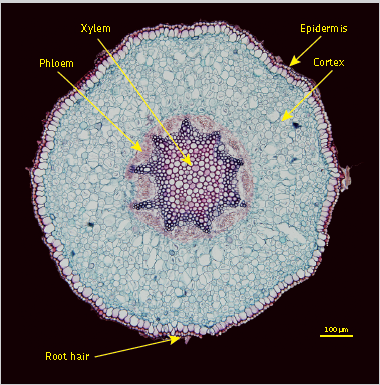Diversity, abundance and biomass
The number of known plant species has been estimated to be around 400,000. The majority (i.e. 260,000 – 290,000 species) belong to seed plants with around 1,000 Gymnosperms. Nearly all the others are classified as flowering plants (Angiosperms). It is difficult to estimate plant root biomass because:
- the fine roots are difficult to sample and
- the separation of living from dead roots is very tedious.
Nevertheless, as a general rule, plants allocate relatively more biomass to roots if the limiting factor for growth is belowground (e.g. water), while they allocate relatively more biomass to shoots if the limiting factor is aboveground (e.g. light). For this reason, a low root biomass is usually typical of plants living in forests and woodlands, while a higher root biomass can be found in desert plants.
Root structure
Observing a cross section of a plant root, the main visible structures are:
- root hair: they have fundamental importance in absorbing water and nutrients and in attaching the plant to the soil or other growing surface. They are lateral extensions of a single cell;
- epidermis: a single-layer group of cells that forms a boundary between the plant and the external environment. Its functions are: protection against water loss, regulation of gas exchanges, and absorption of water and mineral nutrients;
- cortex: formed by unspecialised cells lying between the epidermis and the vascular, or conducting, tissues (xylem and phloem). These cells can be colonised by symbiotic fungi. In some plants, such as carrots, the cortex becomes a storage organ;
- phloem: conducts products of photosynthesis from leaves to roots;
- xylem: conducts water and minerals from the roots up through the plant.
- Typical roots contain meristematic, elongation, and differentiation zones. In the meristematic zone, cells undergo rapid division, creating new cells for root growth. These cells begin to elongate giving the root added length. The zone of differentiation contains mature, specialised cells, such as phloem, xylem, and root hairs.
Note: The effect of synthetic chemicals on root growth
Synthetic fertilisers have been recorded to severely disrupt the function of the phloem and the xylem within the plant root. It is noted that instead of regularity of the cell formation, there are irregularities of cell formation* of these 2 vital structures. (Seen in pink and purple in center of root cross section)
Ref: Global Soil Biodiversity Atlas p. 45
• Wills, Harold Foundations of Natural Farming

